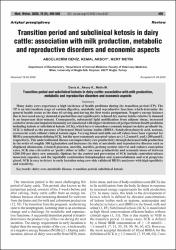| dc.contributor.author | Deniz, Abdülkerim | |
| dc.contributor.author | Aksoy, Kemal | |
| dc.contributor.author | Metin, Mert | |
| dc.date.accessioned | 2020-11-20T14:30:06Z | |
| dc.date.available | 2020-11-20T14:30:06Z | |
| dc.date.issued | 2020 | |
| dc.identifier.issn | 0025-8628 | |
| dc.identifier.uri | https://doi.org/10.21521/mw.6427 | |
| dc.identifier.uri | https://hdl.handle.net/20.500.12809/354 | |
| dc.description | 0000-0002-5242-5671 | en_US |
| dc.description | WOS: 000561474500001 | en_US |
| dc.description.abstract | Many dairy cows experience a high incidence of health problems during the transition period (TP). The TP is an intermediate stage of various digestive, metabolic and reproductive functions which determine the general health status at the time of calving and during the first weeks postpartum. Negative energy balance due to increased energy demand at parturition and significantly reduced dry matter intake relative to demand is an important determinant. Consequently, substantial lipid mobilization from adipose tissue, increased oxidative stress and impaired immunity are associated with higher incidences of periparturient health problems including ketosis or subclinical ketosis (SCK), which have tremendous economic impact on dairy productivity. SCK is defined as the presence of increased blood ketone bodies (BHBA: betahydroxybutyric acid, acetone, acetoacetic acid) without clinical ketosis signs. Varying blood and milk cut-off values have been reported for BHBA concentrations defining SCK, but the most commonly accepted values are >= 1.2 mmol/L and >= 200 mu mol/L respectively. This underestimated disease can impact dairy cow productivity through decreased milk production in the order of roughly 300 kg/lactation and increases the risk of metabolic and reproductive diseases such as displaced abomasum, retained placenta, metritis, mastitis, prolong oestrus interval and reduces conception rates. SCK also referred to as 'profit robber or killer' can cause productivity and economic losses of between $200-290 per dairy cow annually. Options for the control and prevention of SCK include controlled-release monensin capsules, and the injectable combination butaphosphan and cyanocobalamin and oral propylene glycol. SCK is easy to detect in early lactation using cow-side validated BHBA analysers with high specificity and sensitivity. | en_US |
| dc.item-language.iso | eng | en_US |
| dc.publisher | Polish Soc Veterinary Sciences Editorial Office | en_US |
| dc.item-rights | info:eu-repo/semantics/openAccess | en_US |
| dc.subject | Dairy Cow | en_US |
| dc.subject | Metabolic Disease | en_US |
| dc.subject | Transition Period | en_US |
| dc.subject | Subclinical Ketosis | en_US |
| dc.title | Transition period and subclinical ketosis in dairy cattle: association with milk production, metabolic and reproductive disorders and economic aspects | en_US |
| dc.item-type | review | en_US |
| dc.contributor.department | MÜ, Milas Veteriner Fakültesi, Temel Bilimler Bölümü | en_US |
| dc.contributor.institutionauthor | Deniz, Abdülkerim | |
| dc.contributor.institutionauthor | Aksoy, Kemal | |
| dc.contributor.institutionauthor | Metin, Mert | |
| dc.identifier.doi | 10.21521/mw.6427 | |
| dc.identifier.volume | 76 | en_US |
| dc.identifier.issue | 9 | en_US |
| dc.identifier.startpage | 495 | en_US |
| dc.identifier.endpage | 502 | en_US |
| dc.relation.journal | Medycyna Weterynaryjna-Veterinary Medicine-Science and Practice | en_US |
| dc.relation.publicationcategory | Diğer | en_US |


















